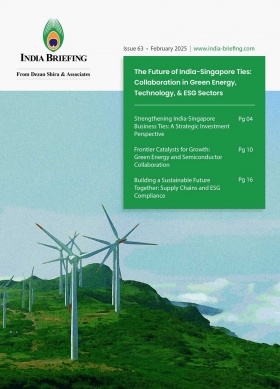India Schedules First Digital Population Census for 2027: What You Need to Know
After a gap of 16 years, the Union Ministry of Home Affairs has set the deadline for conducting India’s next population census on March 1, 2025. This will be the first digital population census.
India Briefing breaks down the latest announcement on the upcoming population census, including the updated timeline and the newly introduced self-enumeration process that will allow individuals to access, update, and verify their household information online.
India’s next population census is scheduled to begin in 2027, according to the official gazette issued by the central government on June 16, 2025. The country-wide census will be conducted in two phases—beginning with the first phase in October 2026, followed by the second phase starting on March 1, 2027. A gazette notification, no. S.O. 2681(E), can be accessed from here: The Gazette of India.
This will be the first population census undertaken under the Narendra Modi-led National Democratic Alliance (NDA) government. Modi’s Bharatiya Janata Party (BJP) came into power in 2014 and is currently serving its third consecutive term under a coalition government of the NDA. The previous census was conducted in 2011, during the tenure of then Prime Minister Dr. Manmohan Singh.
In a media report dated June 6, 2025, the Ministry of Home Affairs stated that India’s nationwide population census—originally planned for 2021—was postponed due to the extensive disruption caused by the COVID-19 pandemic and its lasting effects. The ministry noted that while preparations for the census had been completed, the outbreak ultimately led to the deferral of the exercise.
Two-phase population census in India
India has officially scheduled the 16th decennial census to be conducted in two phases. A decennial census is a population count conducted every ten years by the central government.
- Phase 1: The first phase will begin in snowbound and remote areas of India—such as Jammu & Kashmir, Ladakh, Himachal Pradesh, and Uttarakhand—dated October 1, 2026.
- Phase 2: The second phase of the census is for most parts of the country—dated March 1, 2027.
A notification under Section 3 of the Census Act, 1948, outlines that the housing and household listing phase will be conducted months in advance of the population enumeration, scheduled for March 1, 2027.
India’s census methodology
India’s census is conducted in two primary stages:
1. House listing and housing census: This phase involves visiting every building to gather data on household composition, type of building, construction material, number of rooms, access to water and electricity, sanitation facilities, fuel usage, and ownership of assets such as mobile phones, televisions, and vehicles. It provides critical insights into housing stock and living standards.
The housing census is typically conducted between March and September of the year before population enumeration.
2. Population enumeration: This phase records individual-level data such as name, age, sex, marital status, education, occupation, religion, caste/tribe, disability status, and migration history. Every individual, including the homeless, is counted. The data feed into national statistics on demographic and socioeconomic trends.
For the operations, approximately 3.4 million enumerators and supervisors, along with around 130,000 census functionaries, will be deployed. As per media reports, the provisional data of the census may be released within 10 days of completion, with final results expected within six months from the completion of the process.
Enumerators are individuals responsible for collecting data directly from households and individuals under the census process. They gather the information needed to compile a comprehensive population count and demographic profile.
Enumeration is a core activity of the census process. It involves systematically counting and recording the characteristics of the population, ensuring that every individual is accounted for. This can be carried out through various methods, including face-to-face interviews, mail-in surveys, or online forms, depending on the census design.
ALSO READ: Economic Survey of India 2024-25: Key Highlights
Digital technology to facilitate the population survey
Census 2027 will be India’s first fully digital census, introducing mobile applications, online self-enumeration, and real-time monitoring tools. Enumerators will be equipped with smartphones preloaded with census software, and households will be allowed to self-enumerate via a web portal or mobile app. A unique ID will be generated upon self-enumeration, which residents can present to enumerators for verification.
Self-enumeration digital process
Self-enumeration is a digital initiative that allows individuals to access, update, and validate their household information recorded in the National Population Register (NPR) through an online portal. This process ensures greater convenience, transparency, and accuracy by enabling citizens to complete the exercise independently.
To begin the self-enumeration process, an Indian citizen must visit the official portal of the Office of the Registrar General, Government of India: Click here: https://se.npr.gov.in/npr/
Begin by entering your email ID, solving the captcha, and clicking Submit to proceed.
After this, the user must click the “I Agree” option and choose one of the three available login options to verify their identity:
Option 1: Mobile number and Aadhaar number
- Select a state from the dropdown menu.
- Enter your registered mobile number and 12-digit Aadhaar number.
- Fill in the captcha, tick the declaration checkbox, and click Verify to continue.
Option 2: Mobile number with name and date of birth
- Select a state from the dropdown menu.
- Enter your registered mobile number.
- Provide your full name and date of birth.
- Fill in the captcha, tick the declaration checkbox, and click Verify to proceed.
Option 3: Head of household and member information
Enter all required details, including:
- State, district, tehsil, and town
- Name and date of birth of the head of household
- Name, date of birth, and relationship of another household member
Fill in the captcha, tick the declaration checkbox, and click Verify to proceed. After successful verification through any of the above methods, the user will be redirected to the OTP (One-Time Password) verification screen to authenticate their access and continue with the self-enumeration process.
Digital tools and quality control
India’s Census app reportedly includes features such as Global Positioning System (GPS) integration, geofencing, and real-time error alerts. Enumerators will receive automated prompts for correcting inconsistencies in data, such as improbable ages or unrealistic household sizes. The new coding system replaces previously practiced handwritten entries with standardized, dropdown-based selections for caste, language, occupation, etc. The digitization method is expected to reduce human error and processing time of the data.
As per media reports, the Registrar General and Census Commissioner of India (RGI) has already deployed the necessary digital infrastructure. Enumerators are being trained on mobile applications, geotagging, and cloud-based data uploads. A centralized Census Management and Monitoring System (CMMS) will enable real-time supervision, data validation, and troubleshooting.
Enhanced questionnaire and data collection
It may also be noted that India’s 2027 census will have a revised questionnaire for the house-listing phase that will cover 34 fields, including new parameters such as the following:
- Availability of internet connectivity
- Ownership of mobile phones and smartphones
- Type and source of drinking water
- Type of cooking fuel (liquefied petroleum gas vs. piped gas)
- Vehicle ownership with detailed categories
- Household cereal consumption
- Contact phone number for follow-up or information dissemination
The enumeration schedule will include 28 demographic and socioeconomic indicators. Some of the notable additions in the upcoming census are as follows:
- Comprehensive caste enumeration for all communities
- Expanded categories for migration reasons, including climate-induced displacement
- Questions on use of internet and smartphones
- Explicit identification options for transgender individuals
Importance of the population census
Census plays a critical role in India’s governance and policy planning. It serves as the basis for drawing electoral boundaries and reserving seats for economically marginalized communities under Scheduled Castes (S.C.) and Scheduled Tribes (S.T.). Population data are crucial for distributing central grants, subsidies, and welfare schemes to states and districts.
India’s multiple union ministries—including education, rural development, and health—use census data to plan infrastructure like schools, healthcare centers, and roads. It also informs judiciary rulings, academic research, and public administration by revealing patterns in migration, employment, fertility, and urbanization.
Moreover, the census enables the central government to meet constitutional mandates. Article 82 of the Indian Constitution requires parliamentary constituencies to be redefined based on the latest census, while Articles 330 and 332 of the Indian Constitution govern reservation for economically and socially weaker communities in legislatures based on their demographic share.
Beyond administrative uses, the census acts capture shifts in identity, household structure, economic conditions, and social mobility. It helps design evidence-based policies to serve the evolving needs of the domestic population.
- Previous Article Five Years of India-Australia Comprehensive Strategic Partnership: Key Milestones
- Next Article India’s 2025 Maritime Push with US$20 Billion Investment and Global Ties







